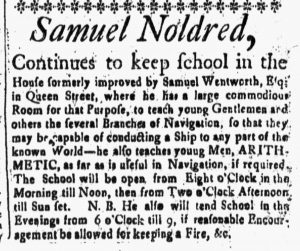What was advertised in a colonial American newspaper 250 years ago today?

“A large experience of 34 years at sea.”
Joseph Atkins took to the pages of the Essex Journal to inform the public that “he still continues to teach reading, writing, and arithmetic” in the spring of 1774. He apparently accepted both boys and girls, though he taught them separately. In a nota bene, he advised that he “intends to open a school for young ladies” at the end of April.
In addition to the basics of reading, writing, and arithmetic, Atkins also provide instruction in navigation “after the most approv[e]d methods. Experience mattered to the schoolmaster, not just experience in the classroom but also experience on ships. He asserted that his confidence in how he taught navigation to his pupils flowed from “a large experience of 34 years at sea.” Navigation was not merely academic to Atkins but instead a practical matter, an essential part of the occupation he previously pursued. Prospective students and their parents, he suggested, should feel similar confidence that his decades at sea prepared him to teach navigation to boys and young men who had prospects of working on vessels themselves. Newburyport was, after all, a maritime community.
The placement of Atkins’s advertisement on the third page of the April 20 edition of the Essex Journal underscored that was the case. It ran immediately below the “MARINE LIST,” a roster of ships that recently “ARRIVED” and “SAILED” from the “PORT of NEWBURY.” A day earlier, the town welcomed the Dove from Antigua and the Newhall from Guadeloupe. Most of the ships that departed in the past ten days made their way to the “West-Indies,” though the Larkventured to Newfoundland. Although Atkins’s time at sea was presumably behind him, he aimed to pass along a valuable skill to young men who might join the crew of any of the vessels that visited Newburyport. His “large experience of 34 years at sea” recommended him as a teacher as much as anything he could say about his methods of instruction.



